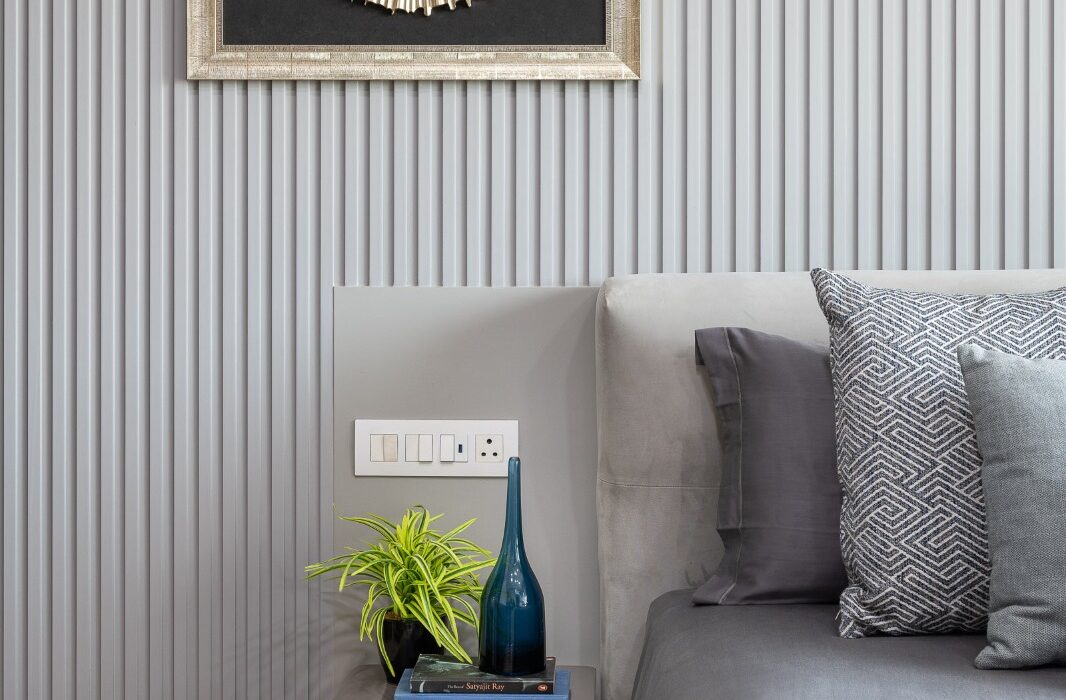When it comes to interior design, creating a space that is both functional and visually striking is key. One of the most effective ways to achieve this balance is by incorporating an accent wall. Accent walls serve as focal points in a room, drawing attention to a specific area and providing a visual anchor for the rest of the decor. They allow homeowners and designers alike to experiment with colors, patterns, textures, and materials in a bold yet controlled way. This blog will guide you through the process of creating an accent wall that transforms your space, offering design tips and ideas for every room.
1. What Is an Accent Wall?
An accent wall, also known as a feature wall, is a single wall that stands out from the rest of the room through the use of color, texture, or materials. Unlike the other walls in the space, which may be painted in a neutral or uniform color, an accent wall introduces a bold visual element that sets the tone for the entire room. It serves as a natural focal point, helping to define the style and mood of the space.
The great thing about accent walls is that they are highly versatile. Whether you want to make a bold statement with a vibrant color or prefer a subtle, textured look, accent walls can be tailored to suit any design preference or room.
2. Why Use an Accent Wall?
Accent walls offer several benefits, both aesthetic and functional:
- Creating a Focal Point: An accent wall naturally draws the eye to a specific part of the room, anchoring the space and giving it a sense of purpose. It helps guide the flow of the room and often highlights architectural features like a fireplace, built-in shelving, or large windows.
- Adding Visual Interest: By introducing contrasting colors, textures, or patterns, an accent wall breaks up the monotony of a room with neutral tones or uniform paint. It adds a layer of depth and interest without overwhelming the space.
- Enhancing Mood and Atmosphere: The design of an accent wall can evoke certain emotions or moods. For example, rich, dark hues create a cozy, intimate feel, while light and bright colors can make a room feel more spacious and airy.
- Highlighting Design Themes: Accent walls allow you to experiment with trends and styles, whether you’re going for a modern, rustic, bohemian, or minimalist look. They are a low-commitment way to try out bold designs without having to redecorate the entire room.
3. Choosing the Right Wall for Your Accent
Before diving into design options, it’s essential to choose the right wall to highlight as an accent. The best choice will depend on the room’s layout, existing features, and the purpose of the space. Here are some tips for selecting the ideal wall:
- Focal Point of the Room: In many rooms, there is already a natural focal point, such as a fireplace, a headboard in a bedroom, or a large window. Using the wall that features this element as your accent wall is a great way to enhance and emphasize it.
- Unobstructed Wall: Ideally, your accent wall should be relatively unobstructed. Avoid walls that are crowded with windows, doors, or large pieces of furniture that may break up the design.
- Walls Opposite Entrances: One popular option is to choose the wall directly opposite the room’s entrance. This ensures that the accent wall is immediately visible when someone enters the room, making it a powerful visual statement.
- Consider Proportions: Make sure the size and shape of the wall suit the design you have in mind. A very small or narrow wall might not have the same impact as a larger, more prominent wall in the room.
4. Choosing the Right Color for Your Accent Wall
Color is one of the easiest and most effective ways to create an accent wall. When selecting a color, it’s important to consider the mood you want to create, as well as how the accent wall will complement the rest of the room’s decor. Here are some tips for choosing the right color:
1. Bold and Dramatic
If you want your accent wall to make a strong visual impact, opt for a bold color that contrasts with the other walls in the room. Rich jewel tones like emerald green, deep navy, or plum can add a touch of sophistication, while bright hues like teal, mustard yellow, or coral can infuse the space with energy and vibrancy.
- Dark Colors for Cozy Spaces: Dark colors like charcoal, navy, or forest green can create a cozy, intimate atmosphere, especially in rooms like bedrooms or living rooms. These tones work well when paired with lighter furniture and decor to create contrast.
- Bright Colors for Energy: Brighter colors are great for spaces that need an extra boost of energy, like home offices, playrooms, or kitchens. Colors like orange, red, or turquoise can add a playful and lively feel to the room.
2. Subtle and Neutral
For those who prefer a more understated look, neutral tones can be just as effective in creating an accent wall. Soft grays, beiges, or taupes offer a sophisticated backdrop without overpowering the space. These tones work particularly well in minimalist or modern designs, where the focus is on clean lines and simplicity.
- Monochromatic Palettes: Another subtle option is to use a monochromatic color scheme, where the accent wall is a darker or lighter shade of the other walls. This approach creates a cohesive and elegant look without being too bold.
3. Consider the Room’s Function
The purpose of the room can help guide your color choice. For example, calming colors like soft blues or greens are ideal for bedrooms, where relaxation is the priority. Meanwhile, vibrant colors can stimulate creativity and productivity in a home office.
4. Complementary Colors
If the room already has a dominant color scheme, choose a complementary or contrasting color for your accent wall. For example, if your living room features a lot of cool tones like gray or blue, a warm accent color like terracotta or mustard can create a visually pleasing contrast.
5. Beyond Paint: Texture and Material for Accent Walls
While paint is a common choice for accent walls, there are many other ways to introduce texture and depth to your feature wall. Materials like wood, stone, brick, or wallpaper can add dimension and personality to your space, making your accent wall truly stand out.
1. Wood Accent Walls
Wood paneling can bring warmth and texture to a room, whether you prefer a rustic, farmhouse look or a sleek, modern design. Options like reclaimed wood, shiplap, or wood slats offer a natural, organic feel and add a sense of craftsmanship to the space.
- Reclaimed Wood: For a more rustic or industrial aesthetic, consider using reclaimed wood as your accent wall material. This type of wood often has unique imperfections, grain patterns, and a weathered look that adds character to the room.
- Wood Slats: For a more contemporary design, vertical or horizontal wood slats can create a streamlined and modern look. This option works well in minimalist interiors and adds a subtle texture without overwhelming the space.
2. Stone or Brick Accent Walls
Natural stone or brick accent walls are perfect for adding a sense of timelessness and durability to a room. These materials offer texture and visual interest while also evoking a sense of warmth and authenticity.
- Exposed Brick: Exposed brick walls, especially in lofts or industrial-style homes, can serve as a stunning focal point. The natural variation in color and texture makes it an eye-catching feature without the need for additional decor.
- Stone Veneer: If you’re looking to achieve the look of stone without the cost or weight, stone veneer panels can mimic the appearance of real stone while being more budget-friendly.
3. Wallpaper
Wallpaper has made a comeback in recent years, offering a wide range of patterns, textures, and designs that are perfect for accent walls. From bold geometric prints to subtle floral patterns, wallpaper allows for endless creativity and customization.
- Textured Wallpaper: If you want to add depth to your accent wall without committing to a physical texture like wood or stone, textured wallpaper is an excellent option. It offers the illusion of texture while being easy to install and remove.
- Bold Patterns: For a dramatic look, opt for wallpaper with a bold, large-scale pattern. Whether it’s a vibrant floral design or an intricate geometric print, patterned wallpaper can make a statement and bring personality to any room.
6. Decorating Around Your Accent Wall
Once your accent wall is complete, it’s important to style the room in a way that complements and enhances the feature wall. Here are some tips for decorating around your accent wall:
1. Keep Furniture Simple
If your accent wall is bold or highly textured, balance it with simpler furniture. Neutral-colored sofas, chairs, or tables will prevent the space from feeling too busy or overwhelming. Let the accent wall be the star of the room, with the rest of the decor serving as supporting elements.
2. Echo the Wall Color
Incorporate accents or accessories in the same color or material as the accent wall to create cohesion. For example, if your accent wall is a deep navy, consider adding navy throw pillows, vases, or artwork to other parts of the room to tie the look together.
3. Use Artwork Sparingly
If you’ve used a bold paint color or textured material for your accent wall, you may not need much additional decor. However, a few well-chosen pieces of artwork or a large mirror can add interest without competing with the wall itself.
4. Lighting Matters
Accent lighting can help highlight your feature wall and draw attention to it. Use wall sconces, floor lamps, or pendant lights to illuminate the wall and create a warm, inviting glow.
7. Accent Walls for Different Rooms
Accent walls can be used in virtually any room of the house, but the design approach may vary depending on the space.
1. Living Room
In a living room, an accent wall can be used to frame a fireplace, TV area, or large piece of artwork. Bold colors or textures work well in this space, as they can anchor the seating arrangement and create a focal point for social gatherings.
2. Bedroom
In the bedroom, the wall behind the headboard is a natural choice for an accent wall. Soft, calming colors or a textured material like wood or wallpaper can create a cozy, serene atmosphere.
3. Kitchen
While less common, accent walls in kitchens can add a unique design element. Consider using a bold tile pattern or a contrasting paint color on the wall behind the dining area or kitchen island.
4. Bathroom
In a bathroom, an accent wall can be created with colorful tiles, wallpaper, or even a bold paint color. Consider highlighting the wall behind the vanity or bathtub for maximum impact.
Conclusion
Creating an accent wall is a simple yet powerful way to elevate the design of any room. Whether through bold colors, textured materials, or patterned wallpaper, an accent wall can add depth, personality, and visual interest to your space. By carefully selecting the right wall, color, or texture, and decorating the room to complement your feature wall, you can transform any space into a beautifully balanced and inviting environment.
Accent walls are not just a design trend; they are a timeless technique for adding flair and focus to a room. Whether you’re designing a modern living room or a cozy bedroom retreat, the right accent wall will help you create a space that reflects your style and makes a lasting impression.

